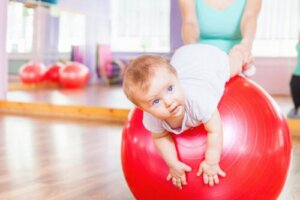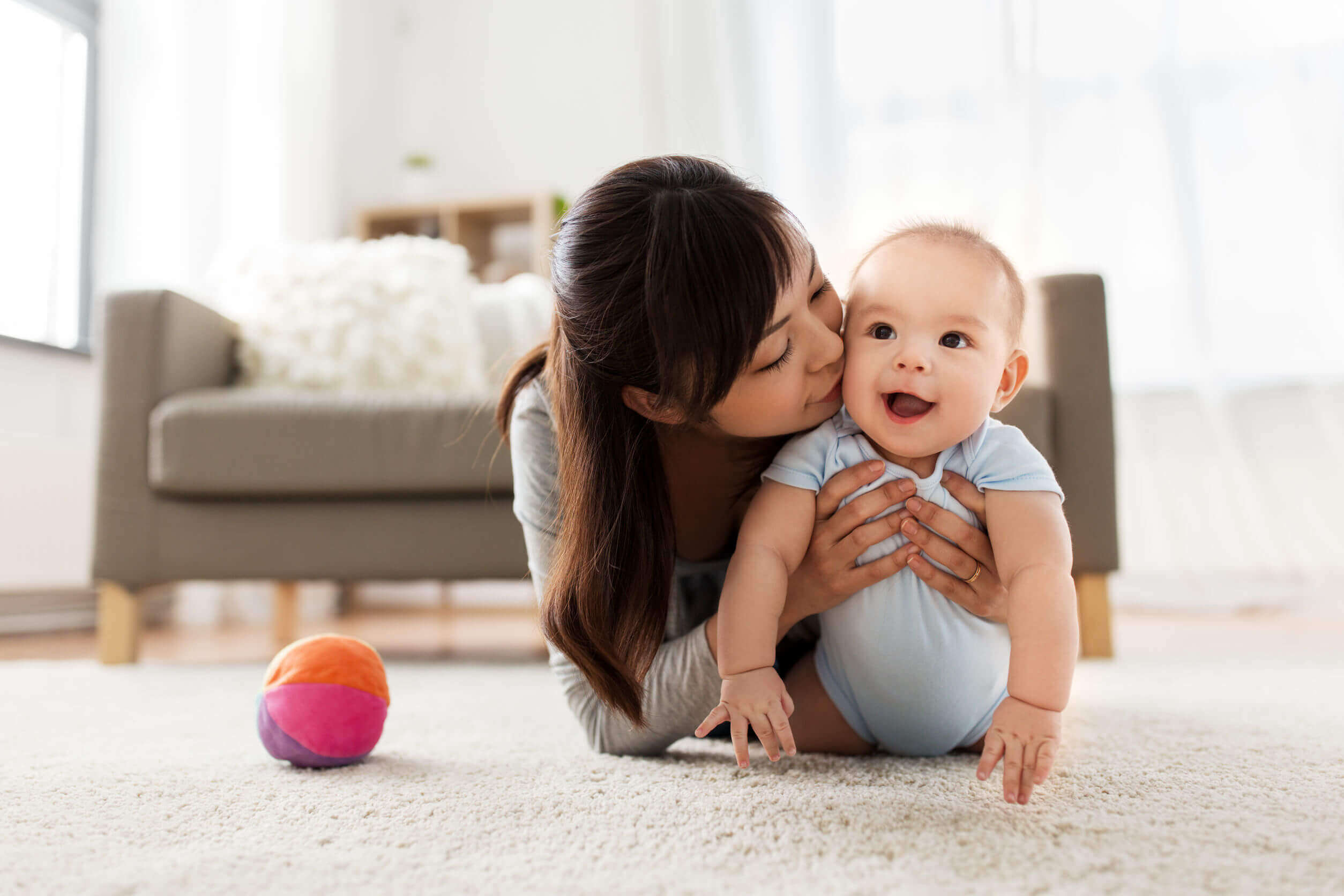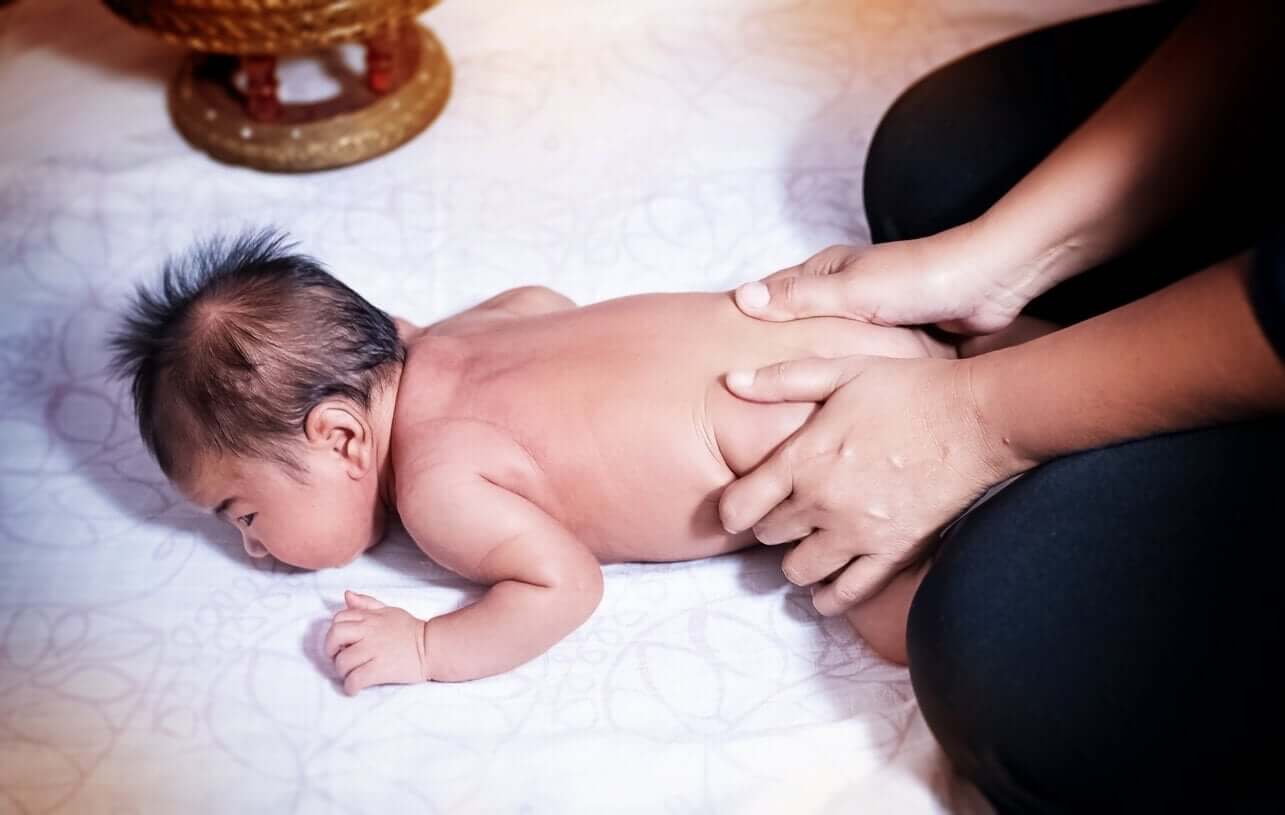Gymnastics for Babies: 4 Stimulation Exercises

Movement is the main axis of the human being and must be present in all stages of our lives. For this reason, gymnastics for babies is so important, both for children and for their parents.
Fortunately, most little ones have an innate need to constantly move and explore. However, as a mother, you must remain aware of their physical and psychological development.
With that in mind, we recommend you implement gymnastics for babies during the first months and even accompany that transition during childhood until adolescence. This is a good way to avoid sedentary lifestyle in your children.
What is gymnastics for babies?
You probably see baby gymnastics as something that’s very elaborate or complex, but don’t get carried away by the name alone. In principle, this kind of gymnastics consists of favoring the movement of children in order to promote their development.
During early childhood, children focus on exploration–getting to know themselves and the world around them. So, gymnastics for babies consists of a series of exercises focused on promoting their need to explore.
Like any activity for little ones, gymnastics for babies must be supervised by parents. However, the parents should limit themselves to being the guides in these stimulation exercises and try not to condition the spontaneous initiatives of the babies.

Benefits of gymnastics for babies
The stimulation exercises offered through gymnastics for babies are a huge incentive for their psychophysical development. Likewise, they promote the maturation of their different capacities: Muscle strengthening, coordination, and motor skills.
At the same time, these activities predispose the body for future movements, such as crawling, walking, and running.
As the baby explores, it also acquires great cognitive benefits. The movements are associated with meaningful and emotional learning, which emerges progressively with each session.
Stimulation exercises for babies
The goal of gymnastics for babies is to encourage them to mature, but at their own pace. For this reason, we advise you to guide your little one with certain movements without forcing them.
1. Upper extremity stimulation
Start by holding both hands of the baby, and if they grab them, all the better. Then, repeatedly perform different movements: Opening and closing, up and down.
Make sure that these movements are harmonious and delicate, in order to avoid any injury. Don’t forget they shouldn’t cause discomfort to the baby, so stop if you perceive that they’re refusing to do them.
2. Lower limb stimulation
Exercises to stimulate the legs are similar to those for the arms. In this case, you must take both ankles and perform abduction and adduction movements, that is, open and close both legs at the same time.
It’s also advisable to flex each leg at the level of the patellar joint. Bring the baby’s leg slowly toward the abdomen or slightly higher. Then do the same with the other one.
In gymnastics for babies, stimulation through caresses stands out, so run your hands over the different parts of their body to stimulate movement. If you notice that the little one is upset, stop doing it immediately.
3. Back stimulation
This stimulation exercise is a bit more elaborate, so be careful.
When your baby is lying on their stomach, you must take them by both legs and lift them in a controlled way. The body must remain supported, since the objective is to stimulate the muscles of the back and lower back.
This stimulus should only last a few seconds. If you don’t feel capable of doing this exercise, you can ask your partner for help or consult your pediatrician.

You may be interested: Psychological Benefits of Baby Massage
4. Free exploration
Although it’s not specifically a stimulation exercise, it favors the psychophysical development of babies. This pedagogical model called “free movement” was created by Emmi Pikler and focuses on free exploration.
The main objective of this model is to respect the timing and the initiative of little ones in their task of discovering the world. And their parents, must remain as their guides and intervene only as necessary and justified.
Ideally, each child should be allowed to be carried away by curiosity to explore and learn gradually.
We advise you to prepare the environment in which the child is going to move. Make sure there are no dangerous or toxic elements within their reach.
Baby gymnastics, please note
Before carrying out any stimulation exercise, you need to take into account a series of aspects. As a mother, it’s easier to understand your baby, and you probably know what they require at all times or according to their mood.
Based on this, try not to perform baby gymnastics in the moments after eating the food or pressuring your child when they’re hungry or sleepy. In both cases, their concentration will be very dissipated and the experience will be unpleasant.
Apart from that, try to put comfortable clothes on them and make sure that they have a clean diaper every time they go to do this type of exercise.
Movement is the main axis of the human being and must be present in all stages of our lives. For this reason, gymnastics for babies is so important, both for children and for their parents.
Fortunately, most little ones have an innate need to constantly move and explore. However, as a mother, you must remain aware of their physical and psychological development.
With that in mind, we recommend you implement gymnastics for babies during the first months and even accompany that transition during childhood until adolescence. This is a good way to avoid sedentary lifestyle in your children.
What is gymnastics for babies?
You probably see baby gymnastics as something that’s very elaborate or complex, but don’t get carried away by the name alone. In principle, this kind of gymnastics consists of favoring the movement of children in order to promote their development.
During early childhood, children focus on exploration–getting to know themselves and the world around them. So, gymnastics for babies consists of a series of exercises focused on promoting their need to explore.
Like any activity for little ones, gymnastics for babies must be supervised by parents. However, the parents should limit themselves to being the guides in these stimulation exercises and try not to condition the spontaneous initiatives of the babies.

Benefits of gymnastics for babies
The stimulation exercises offered through gymnastics for babies are a huge incentive for their psychophysical development. Likewise, they promote the maturation of their different capacities: Muscle strengthening, coordination, and motor skills.
At the same time, these activities predispose the body for future movements, such as crawling, walking, and running.
As the baby explores, it also acquires great cognitive benefits. The movements are associated with meaningful and emotional learning, which emerges progressively with each session.
Stimulation exercises for babies
The goal of gymnastics for babies is to encourage them to mature, but at their own pace. For this reason, we advise you to guide your little one with certain movements without forcing them.
1. Upper extremity stimulation
Start by holding both hands of the baby, and if they grab them, all the better. Then, repeatedly perform different movements: Opening and closing, up and down.
Make sure that these movements are harmonious and delicate, in order to avoid any injury. Don’t forget they shouldn’t cause discomfort to the baby, so stop if you perceive that they’re refusing to do them.
2. Lower limb stimulation
Exercises to stimulate the legs are similar to those for the arms. In this case, you must take both ankles and perform abduction and adduction movements, that is, open and close both legs at the same time.
It’s also advisable to flex each leg at the level of the patellar joint. Bring the baby’s leg slowly toward the abdomen or slightly higher. Then do the same with the other one.
In gymnastics for babies, stimulation through caresses stands out, so run your hands over the different parts of their body to stimulate movement. If you notice that the little one is upset, stop doing it immediately.
3. Back stimulation
This stimulation exercise is a bit more elaborate, so be careful.
When your baby is lying on their stomach, you must take them by both legs and lift them in a controlled way. The body must remain supported, since the objective is to stimulate the muscles of the back and lower back.
This stimulus should only last a few seconds. If you don’t feel capable of doing this exercise, you can ask your partner for help or consult your pediatrician.

You may be interested: Psychological Benefits of Baby Massage
4. Free exploration
Although it’s not specifically a stimulation exercise, it favors the psychophysical development of babies. This pedagogical model called “free movement” was created by Emmi Pikler and focuses on free exploration.
The main objective of this model is to respect the timing and the initiative of little ones in their task of discovering the world. And their parents, must remain as their guides and intervene only as necessary and justified.
Ideally, each child should be allowed to be carried away by curiosity to explore and learn gradually.
We advise you to prepare the environment in which the child is going to move. Make sure there are no dangerous or toxic elements within their reach.
Baby gymnastics, please note
Before carrying out any stimulation exercise, you need to take into account a series of aspects. As a mother, it’s easier to understand your baby, and you probably know what they require at all times or according to their mood.
Based on this, try not to perform baby gymnastics in the moments after eating the food or pressuring your child when they’re hungry or sleepy. In both cases, their concentration will be very dissipated and the experience will be unpleasant.
Apart from that, try to put comfortable clothes on them and make sure that they have a clean diaper every time they go to do this type of exercise.
All cited sources were thoroughly reviewed by our team to ensure their quality, reliability, currency, and validity. The bibliography of this article was considered reliable and of academic or scientific accuracy.
- Sánchez-Pérez, C., Rivera-González, R., Correa-Ramírez, A., Figueroa, M., Sierra-Cedillo, A., & Izazola, S. C. (2015). The development of the child up to 12 months. Orientations to the pediatrician for its surveillance with the family. In Acta Pediatrica de Mexico. http://www.scielo.org.mx/scielo.php?script=sci_arttext&pid=S0186-23912015000600480
- Sagastui, J., Herrán, E., & Anguera, M. T. (2020). A Systematic Observation of Early Childhood Educators Accompanying Young Children’s Free Play at Emmi Pikler Nursery School: Instrumental Behaviors and Their Relational Value. Frontiers in Psychology. https://doi.org/10.3389/fpsyg.2020.01731
This text is provided for informational purposes only and does not replace consultation with a professional. If in doubt, consult your specialist.








